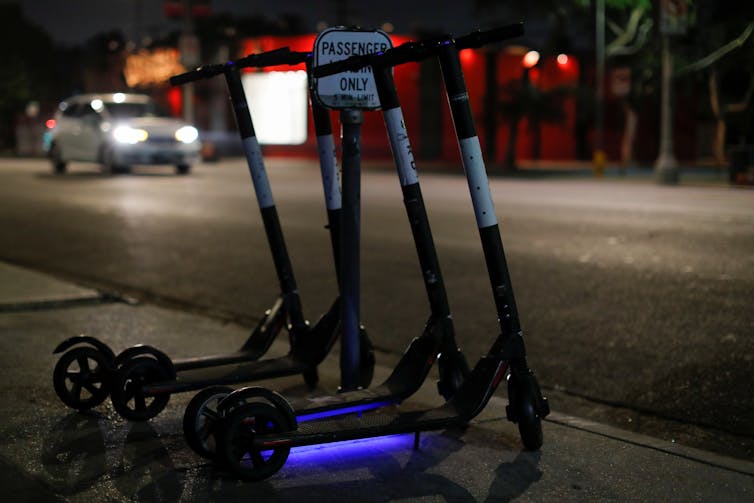Instagram posts suggest e-scooter companies like Bird aren't promoting safe riding to newbies
- Written by Jon-Patrick Allem, Research Scientist, University of Southern California
Since emerging[1] in the U.S. last year, electric scooters have become an increasingly popular[2] way for people to travel short distances, thanks to their speed and convenience. But they’ve also generated controversy and concerns[3] about their safety.
Recently, nine people who say they’ve been injured by e-scooters filed a class-action lawsuit[4] against startups Bird and Lime, accusing them of “gross negligence,” “aiding and abetting assault” and failing to include adequate safety instructions for riders.
I study[5] ways to inform public health and policy by using data from social media. Research shows that the ways in which companies promote and demonstrate use of their products or services through social media influences consumer behavior[6].
Instagram in particular has become an important way[7] for startups like Bird to communicate with their customers. And since the company calls safety[8] its “obsession,” my colleague[9] and I wanted to determine how well it telegraphed this to its followers.
 Bird electric scooters stand on a sidewalk on Melrose Avenue in Los Angeles.
Reuters/Mike Blake[10]
Bird electric scooters stand on a sidewalk on Melrose Avenue in Los Angeles.
Reuters/Mike Blake[10]
Riding risks
E-scooters are a relatively new phenomenon in the ride-share economy.
Customers typically must download applications onto their smartphones, which then direct them to the nearest e-scooter available for rent. Riders can travel at speeds of up to 15 miles an hour and then abandon the scooter once they’ve reached their destination, wherever convenient.
But that convenience has a cost. Powered two-wheelers are extremely vulnerable to road risks[11]. Hundreds[12] of riders and pedestrians have been injured[13] by e-scooters, and three have died.
Bird’s Instagram feed
My colleague and I conducted a study that looks at the ways Bird portrays the use of its e-scooters to customers. It was recently published in Preventive Medicine Reports[14].
We chose Bird because it’s among the largest e-scooter-sharing companies, operating in 30 U.S. cities with plans to expand across the globe. It’s valued at US$2 billion[15], has more than 69,000 followers on its Instagram account[16] and has been praised[17] for its use of social media in distinguishing itself from competitors.
We analyzed all 324 posts to Bird’s account from Sept. 22, 2017, through November 9, 2018. If there were any people in the photo, we examined whether there was an e-scooter visible and whether the individuals were wearing any protective gear, such as a helmet, wrist guards or elbow and knee pads. We then looked at the comment section to see if protective gear or safety was mentioned.
We found that 69 percent of the 324 posts contained a person visible with a Bird e-scooter. Of those, only 6.2 percent showed someone wearing any protective gear. About 6.8 percent of the images displayed safety gear in the background. Just 1.5 percent of the posts mentioned safety in the comment box.
Over two-thirds of the posts to Bird’s Instagram account were reposts from customers, suggesting that documenting their actual experience with e-scooters is part of the company’s marketing plan.
Bird offers free helmets[18] to all active riders (as long as they cover shipping) and explicitly encourages them to wear one.
Yet by reposting its customers’ photos without wearing protective gear, Bird sends a signal to its followers that it approves of customers riding without a helmet.
Scooter safety
So what to make of this?
Our findings are limited to one social media account from a single e-scooter company and do not consider Bird’s other ways of communicating with its customers. Traditional survey-based research is still needed to document the use of protective gear while operating these two-wheelers.
But at a minimum, our findings suggest that one of the leading e-scooter-sharing companies is not emphasizing the safe use of its products as a part of its promotional activities on Instagram.
And lawmakers appear to be following suit. A new California law[19], sponsored by the e-scooter industry[20], will allow adults[21] to ride without a helmet and all users to travel on sidewalks, overturning previous rules.
Given the growing number of injuries and even deaths that have been reported involving e-scooters, I believe it may be up to health officials to emphasize the importance of using protective gear and following safe riding practices.
References
- ^ emerging (www.bloomberg.com)
- ^ increasingly popular (www.vox.com)
- ^ generated controversy and concerns (theconversation.com)
- ^ class-action lawsuit (www.washingtonpost.com)
- ^ I study (scholar.google.com)
- ^ influences consumer behavior (doi.org)
- ^ important way (clickfirstmarketing.com)
- ^ calls safety (www.bird.co)
- ^ colleague (scholar.google.com)
- ^ Reuters/Mike Blake (pictures.reuters.com)
- ^ vulnerable to road risks (doi.org)
- ^ Hundreds (www.buzzfeednews.com)
- ^ have been injured (www.bloomberg.com)
- ^ Preventive Medicine Reports (www.sciencedirect.com)
- ^ valued at US$2 billion (www.inc.com)
- ^ Instagram account (www.instagram.com)
- ^ been praised (www.refinery29.com)
- ^ free helmets (www.bird.co)
- ^ California law (leginfo.legislature.ca.gov)
- ^ sponsored by the e-scooter industry (www.cnet.com)
- ^ will allow adults (la.curbed.com)
Authors: Jon-Patrick Allem, Research Scientist, University of Southern California

